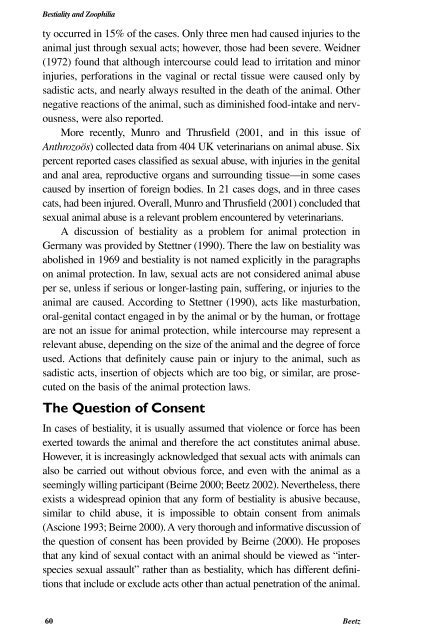Bestiality and zoophilia - Evolve For Animals
Bestiality and zoophilia - Evolve For Animals
Bestiality and zoophilia - Evolve For Animals
You also want an ePaper? Increase the reach of your titles
YUMPU automatically turns print PDFs into web optimized ePapers that Google loves.
<strong>Bestiality</strong> <strong>and</strong> Zoophiliaty occurred in 15% of the cases. Only three men had caused injuries to theanimal just through sexual acts; however, those had been severe. Weidner(1972) found that although intercourse could lead to irritation <strong>and</strong> minorinjuries, perforations in the vaginal or rectal tissue were caused only bysadistic acts, <strong>and</strong> nearly always resulted in the death of the animal. Othernegative reactions of the animal, such as diminished food-intake <strong>and</strong> nervousness,were also reported.More recently, Munro <strong>and</strong> Thrusfield (2001, <strong>and</strong> in this issue ofAnthrozoös) collected data from 404 UK veterinarians on animal abuse. Sixpercent reported cases classified as sexual abuse, with injuries in the genital<strong>and</strong> anal area, reproductive organs <strong>and</strong> surrounding tissue—in some casescaused by insertion of foreign bodies. In 21 cases dogs, <strong>and</strong> in three casescats, had been injured. Overall, Munro <strong>and</strong> Thrusfield (2001) concluded thatsexual animal abuse is a relevant problem encountered by veterinarians.A discussion of bestiality as a problem for animal protection inGermany was provided by Stettner (1990). There the law on bestiality wasabolished in 1969 <strong>and</strong> bestiality is not named explicitly in the paragraphson animal protection. In law, sexual acts are not considered animal abuseper se, unless if serious or longer-lasting pain, suffering, or injuries to theanimal are caused. According to Stettner (1990), acts like masturbation,oral-genital contact engaged in by the animal or by the human, or frottageare not an issue for animal protection, while intercourse may represent arelevant abuse, depending on the size of the animal <strong>and</strong> the degree of forceused. Actions that definitely cause pain or injury to the animal, such assadistic acts, insertion of objects which are too big, or similar, are prosecutedon the basis of the animal protection laws.The Question of ConsentIn cases of bestiality, it is usually assumed that violence or force has beenexerted towards the animal <strong>and</strong> therefore the act constitutes animal abuse.However, it is increasingly acknowledged that sexual acts with animals canalso be carried out without obvious force, <strong>and</strong> even with the animal as aseemingly willing participant (Beirne 2000; Beetz 2002). Nevertheless, thereexists a widespread opinion that any form of bestiality is abusive because,similar to child abuse, it is impossible to obtain consent from animals(Ascione 1993; Beirne 2000). A very thorough <strong>and</strong> informative discussion ofthe question of consent has been provided by Beirne (2000). He proposesthat any kind of sexual contact with an animal should be viewed as “interspeciessexual assault” rather than as bestiality, which has different definitionsthat include or exclude acts other than actual penetration of the animal.60 Beetz


